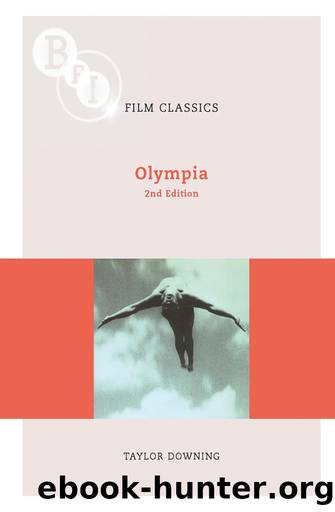Olympia by Downing Taylor;

Author:Downing, Taylor;
Language: eng
Format: epub
Publisher: BFI Publishing
Published: 2019-06-15T00:00:00+00:00
5 The Prologue and Opening Ceremony
Olympia begins with a stunning opening sequence. For twelve minutes the film evokes a classical past and celebrates the human form. The opening suggests the power and beauty of the human body in motion, themes which underlie the whole film. The camerawork shows the force of Riefenstahlâs imagination, the influence of her early career as a dancer and the genius of the team working with her, especially Willy Zielke. The photography provides a haunting set of images, setting the film in its epic proportions. The opening sequence tells us that Olympia will be much more than a documentary about a sporting event: it will affect us on a far more profound level.
The opening credits mention only two names. In the English version, Leni Riefenstahl is credited as producer and the other credit is for the music by Herbert Windt. In the original German version, the words used to describe Riefenstahl are not the conventional term for director, âRegieâ, but âGesamtleitung and Künstlerische Gestaltungâ, or roughly âunder the leadership and artistic supervision ofâ. With the team Riefenstahl gathered round her to produce the film and with the amount of material shot, it is interesting that she should use this term to describe her role. Curiously, there is no attempt to replicate this concept on foreign versions of the film, where she is credited not as the director but as the producer.42
The opening shots mix through swirling clouds to classical ruins. To the ponderous Wagnerian rhythms of Windtâs music, the camera tracks across broken columns scattered over the ground and mixes to further ruins. With the camera still moving, the film dissolves to a long shot of a Greek temple arising out of the ruins. The camera tracks round this temple and finally the film mixes to a static wide shot of the Parthenon, which fills the screen with its magnificence. Tracking past the Doric columns, the film dissolves to a series of close-ups of faces of Greek statues â Medusa, Aphrodite and Apollo. Then, with the camera on the move again, the film dissolves to wider shots of the statues of Aphrodite and the Faun and back to the heads of Achilles and Paris. One head is superimposed over another. Finally, we arrive at the naked statue of Myronâs discus thrower and, as the camera rotates past the statue, the film mixes to live action of an almost naked man who comes to life throwing the discus. After the slow rhythm of the images of classical antiquity, the music changes pace and the film erupts with a montage of low-angle images of men throwing the discus, putting the shot and throwing the javelin.
The pace slows again and the camera lingers on an image of the putting shot being tossed from one outstretched hand to another. There is then a slow mix to arms waving, like corn in the wind, in the same rhythm as the shot putter. Another mix reveals a naked female dancer, who moves at the same gentle pace as the arms in the wind.
Download
This site does not store any files on its server. We only index and link to content provided by other sites. Please contact the content providers to delete copyright contents if any and email us, we'll remove relevant links or contents immediately.
The Kite Runner by Khaled Hosseini(4952)
Gerald's Game by Stephen King(4375)
Dialogue by Robert McKee(4160)
The Perils of Being Moderately Famous by Soha Ali Khan(4064)
Story: Substance, Structure, Style and the Principles of Screenwriting by Robert McKee(3330)
The 101 Dalmatians by Dodie Smith(3300)
The Pixar Touch by David A. Price(3209)
Confessions of a Video Vixen by Karrine Steffans(3100)
How Music Works by David Byrne(2964)
Fantastic Beasts: The Crimes of Grindelwald by J. K. Rowling(2843)
Slugfest by Reed Tucker(2803)
Harry Potter 4 - Harry Potter and The Goblet of Fire by J.K.Rowling(2801)
The Mental Game of Writing: How to Overcome Obstacles, Stay Creative and Productive, and Free Your Mind for Success by James Scott Bell(2766)
4 - Harry Potter and the Goblet of Fire by J.K. Rowling(2530)
Screenplay: The Foundations of Screenwriting by Syd Field(2435)
Scandals of Classic Hollywood: Sex, Deviance, and Drama from the Golden Age of American Cinema by Anne Helen Petersen(2395)
Wildflower by Drew Barrymore(2378)
The Complete H. P. Lovecraft Reader by H.P. Lovecraft(2366)
Casting Might-Have-Beens: A Film by Film Directory of Actors Considered for Roles Given to Others by Mell Eila(2306)
